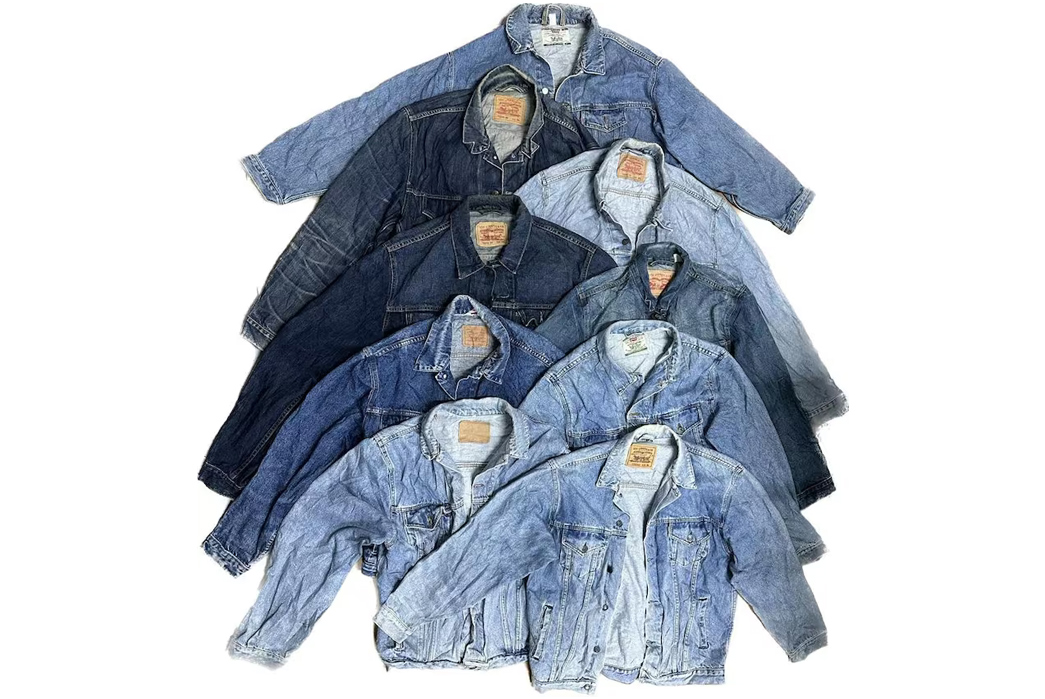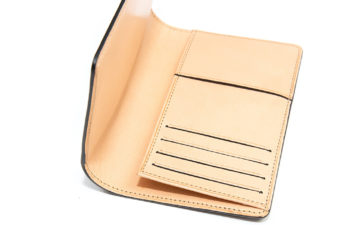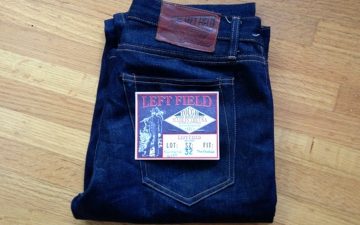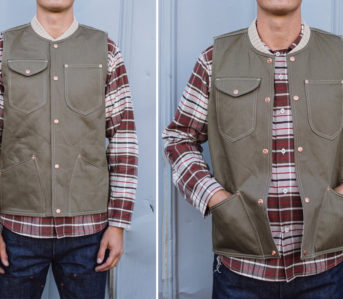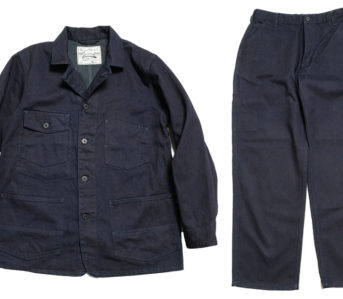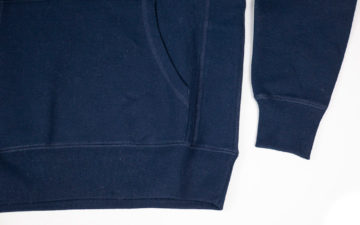We all want high-quality denim goods, but we don’t always want to buy them brand new, or we simply can’t afford to. High costs aside, sometimes we just can’t be bothered with breaking in new raw denim, we might really want something that’s already broken in, pre-washed, and faded. There’s nothing wrong with wanting quality-made raw denim faded and distressed ahead of time, even if you didn’t set the creases and honeycombs yourself, worn-in denim goods are eternally cool looking. You might even be looking for your discontinued denim grails (ROY jeans, anyone?), but you’re not exactly sure how and where to find them.
sIn this definitive guide to buying and selling secondhand denim, we’ll be guiding you through the process of how to find, or let go of new, like-new, deadstock, used, and rare secondhand denim goods. You can trust us – we have years of experience in buying, selling, and trading high-quality denim products on the various platforms detailed within.
Why Buy Secondhand?
Buying secondhand is smart in a lot of ways. It saves you money, for one thing. If the denim is already broken in, chances are good that you’re not paying full price (this isn’t always the case, some secondhand clothing vendors up-charge for rare, highly broken-in, distressed, and faded raw denim items). Secondly, you’re eliminating a lot of invisible fees, like import fees, taxes, etc. by avoiding purchasing an item new.
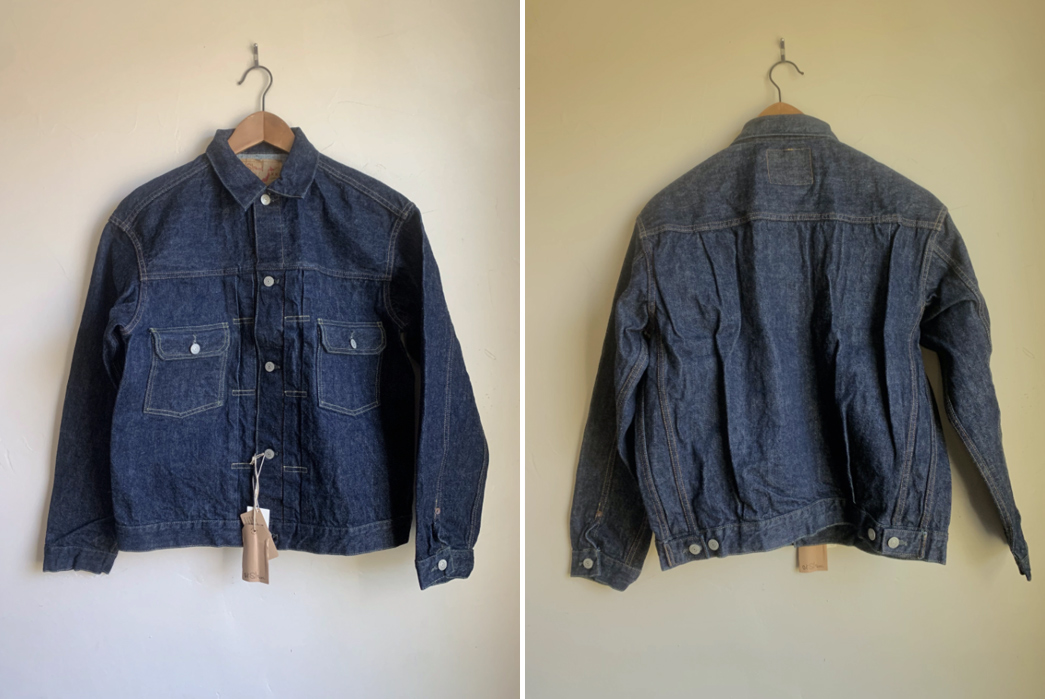
A new with tags orSlow ‘1950s’ Type II Raw Selvedge Denim Jacket, available for $275 on Grailed, $125 below its retail price.
It’s possible to find barely worn high-quality goods for below the suggested retail price (or sometimes far below retail price, even next to nothing), and we’re going to show you how it can be done. You can even find something unique that you’d never considered purchasing before in the process of browsing the secondhand markets we’ll be discussing.
It’s also more sustainable to buy secondhand denim goods, ensuring that the items you’re buying or selling get a second life, and (hopefully) fall into the hands of careful owners who will wear them until the denim is threadbare.
Selling Secondhand
Unfortunately, not every single piece of raw denim we buy works out in the end. You might have outgrown the denim (physically or stylistically), you might have altered or hemmed the denim in a way that no longer suits you, or you might simply need some extra cash. Sometimes getting the most out of your quality raw denim means selling it to recoup some of its cost. This is completely normal, and it’s good to recognize that high-quality garments hold value, and getting back some (or all) of that value is entirely possible.
Maybe you found a killer pair of vintage made-in-USA Levi’s at the thrift, but they’re not your size, guess what? You can sell them on one of the platforms below. Most of these platforms make it incredibly easy to list an item.
Here are our tips for maximizing your chances of making bank when selling secondhand denim.
Describing the denim
When listing on an online platform like eBay or Grailed, be sure to include all model information. Denimheads are going to want to know what specific model they’re buying, the weight of the denim, the cut, and any special details about the fabric or silhouette, etc.
Buyers are also going to want to know all the details of the quality and condition of the item. Be honest about the overall cleanliness (always clean your items before selling) and condition, and scan the item for flaws or damage like holes, crotch blowouts, rubbing, cuff fraying, staining, marbling, exposure to smoke/fire, etc.
It’s important to include the number, or estimate, of washes/soaks on the denim, unsanforized or not, if you have that information. Or, if the denim was rinsed/pre-shrunk prior to your purchase, include that information. Sometimes including a bit of the denim’s story and background goes a long way with potential buyers, and they’ll end up trusting you more, leaving you good feedback in the end.
Exercise patience and professionalism, buyers are going to ask a lot of questions, try to haggle you down to a lower price, etc. Stand behind your product if you’re looking to recoup your money, you know the value of a piece, its rarity, etc., then don’t settle for much less than your asking price.
Measuring the Denim
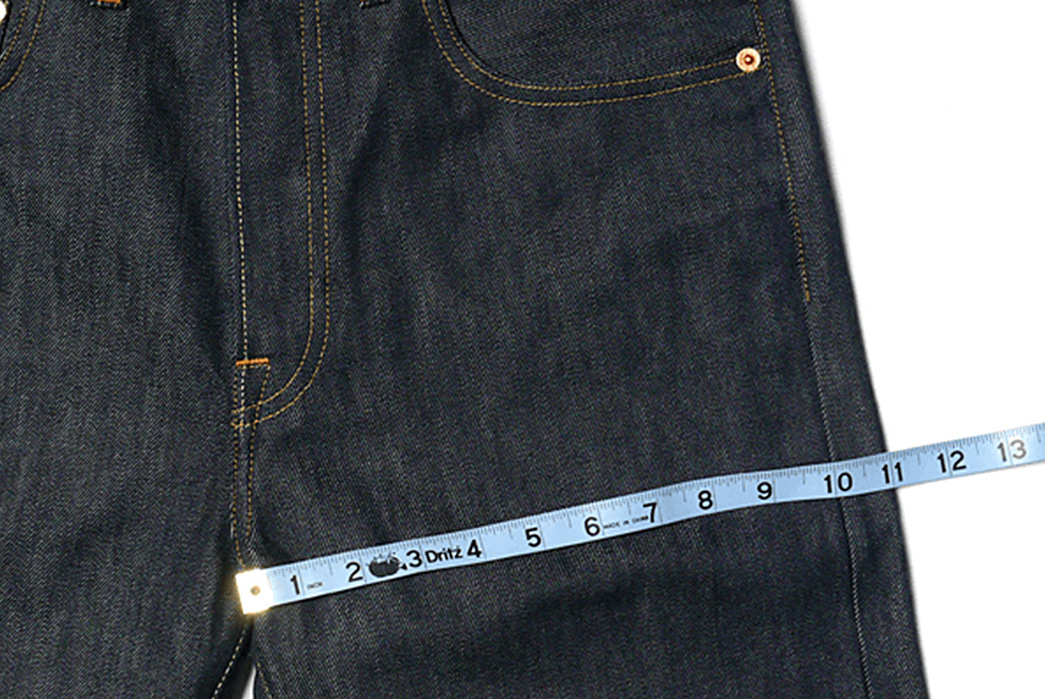
Including measurements is crucial when listing high-quality denim ( or any garment, really) for sale. Buyers are likely going to request measurements if you have none listed. Be sure to be super transparent about the measurements, and how they’re measured, use our guide to measuring denim (or make use of various retail platforms measuring guides) if you aren’t familiar with the process.
You’ll need a soft measuring tape or a tailor’s measuring tape that’s flexible enough to measure clothes with.
For jeans, measure:
- Waist (typically it’s the waistband laid flat or waist pulled taught multiplied by 2)
- Inseam (from the center of the crotch down to the leg opening)
- Thigh
- Knee
- Leg opening (hem)
- Front and back rise
For denim jackets and shirting, measure:
- Chest (pit to pit)
- Shoulder measurement (from the widest points of the shoulder across)
- Sleeve measurement (measured on the outside of the arm, not the inside)
- The back length (measure from the seam under the collar straight down to the hem)
Photographing the Denim
Make sure to take clear photographs of the item you’re selling. Buyers don’t expect professional, studio-quality photographs from every listing, but it’s best if you can photograph the item against a clear/blank background on an appropriate hanger. If you have a light-colored blank wall, dedicated hangers for product listing, a small nail or hook to hang the garment on, and a smartphone — you’ve got a budget home studio suitable for selling any piece of clothing online.
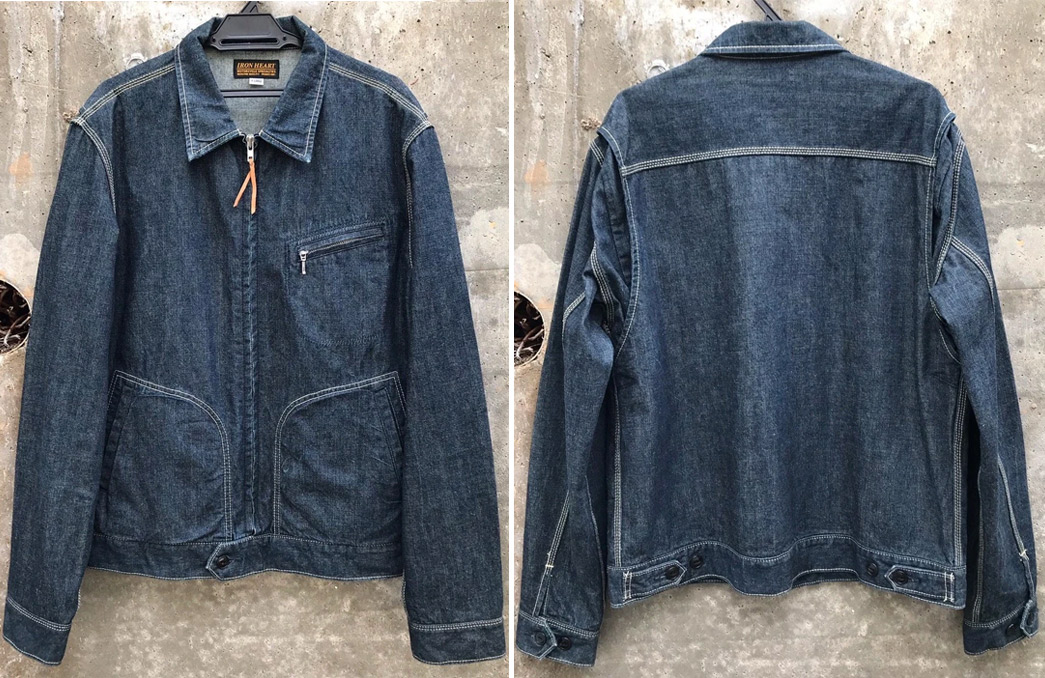
A well-photographed Iron Heart jacket for sale on Grailed.
Whether you hang up your garment or lay it flat on a clean surface, make sure the garment is clean and spread nicely sothat the silhouette and details are clear. If the lighting is bad, try to photograph it near a window during a well-lighted time of day. Try not to upload bad photographs with glare, clutter, or wrinkly-looking items – they won’t sell as well as something more clean and semi-professional looking.
If you’re listing jeans, photograph:
- Flat lay or hung shot of the front back of the jean
- Selvedge ID
- Hem
- Back pocket
- Arcuates
- The manufacturer’s tag, waist patch, and other labels/branding
- Close-ups of the denim, any fading or damage/staining
- Any special details of the jean
If you’re listing shirting/jackets, photograph:
- Flat lay or hung shot of the front back of the item
- Shots of cuffs, collar, and button placket
- Shots of details like branding, inside, manufacturer’s tag, closeup on the denim/fading, and any damage/staining/significant features of the fabric
If the item you’re featuring is rare or limited, or has physical details that are special, be sure to include them. Things like collaboration leather patches, embossed metal hardware, rare proprietary denim, collector’s tote bags, etc.
Here is a good example of a well-photographed pair of secondhand jeans, via AnnStores on Grailed. Bright natural lighting, close-ups, a plain-ish background that allows the denim to stand out, and clear illustration of the “flaws”.
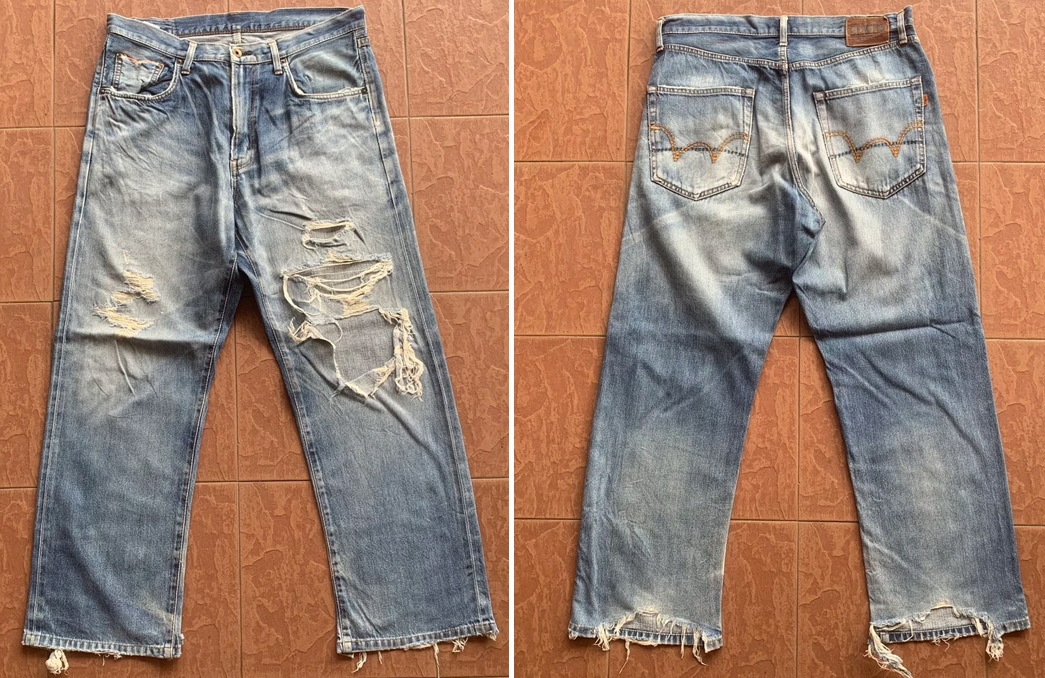
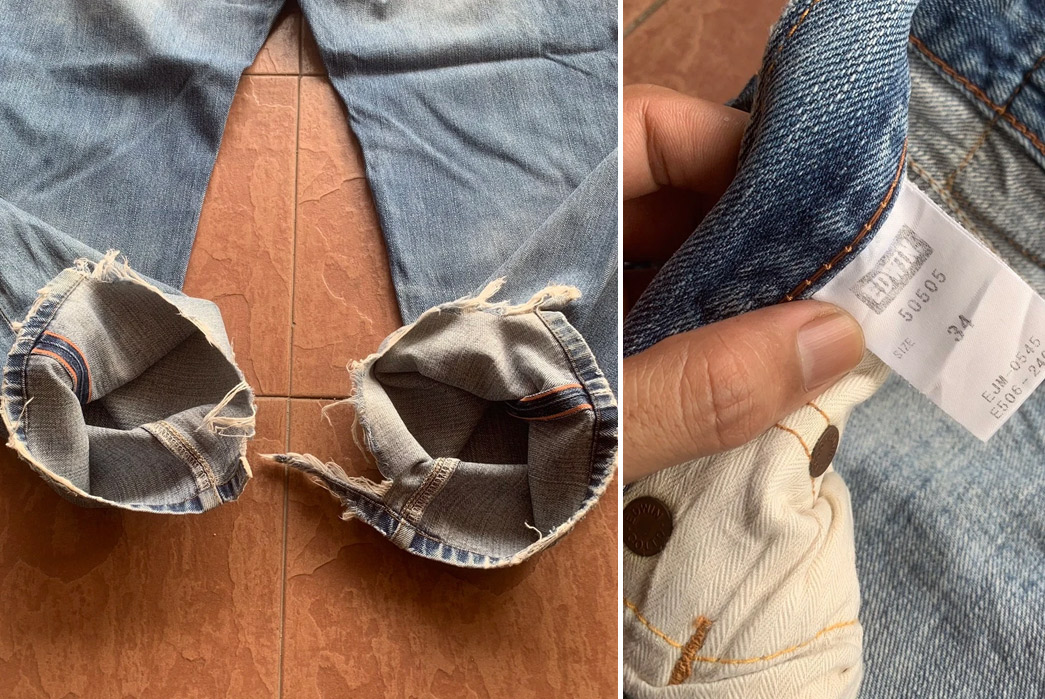
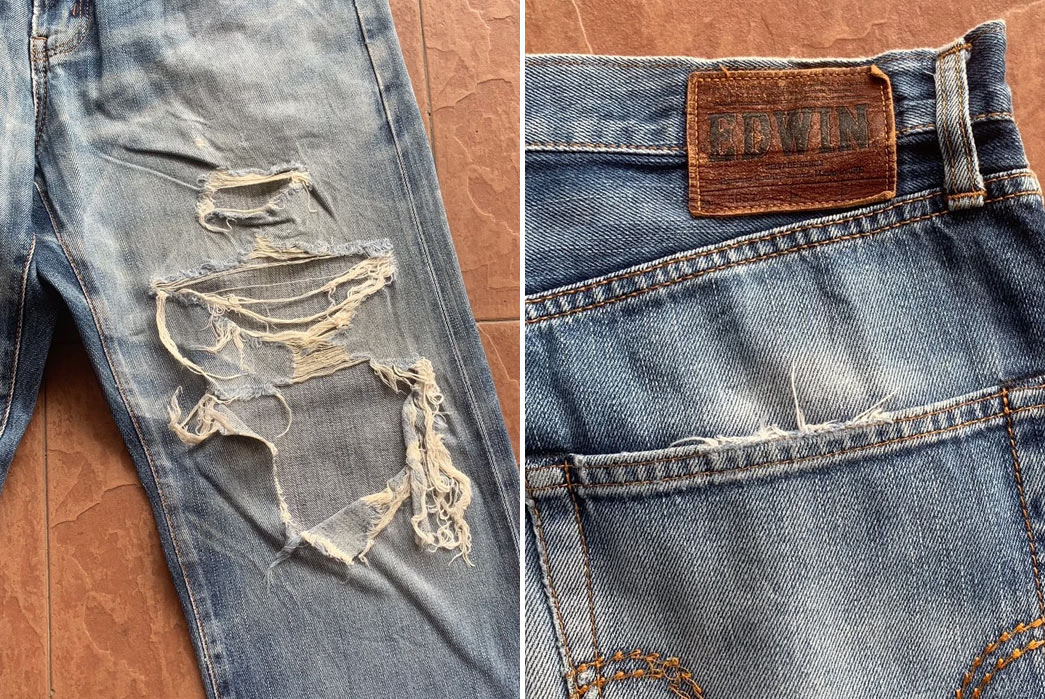
Platforms for Buying & Selling Denim Goods
eBay
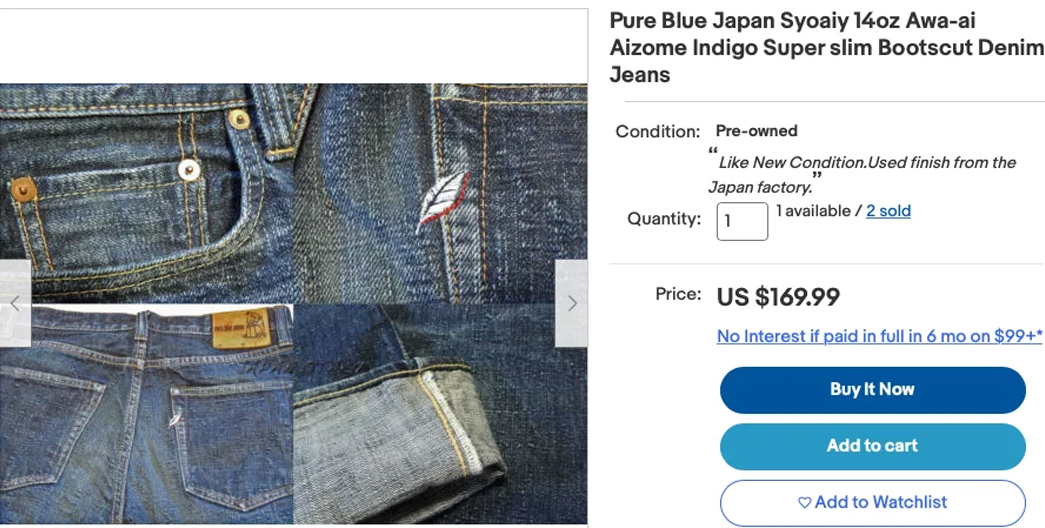
eBay is the online auction place to find almost endless amounts of secondhand pieces. It’s not geared specifically toward clothes, but it’s packed with high-quality clothes from sellers who know don’t always know the value of their products. Because of this, you can find incredible deals on eBay with enough time, patience, and skill in searching.
Buying on eBay
Pros:
- Cost-effective – If you’ve ever won an auction on eBay, you know that there’s a lot of money to be saved by seeking out secondhand goods sold on this platform.
- Rare items – With patience and repeated searches on eBay, you can find almost anything, that includes rare and discontinued denim goods that have long since disappeared from retail shelves.
- Trusted platform with great buyer protection – eBay is renowned for protecting buyers if purchases go wrong. If your item doesn’t arrive or doesn’t arrive as described, they usually have your back.
- Fantastic mobile app – eBay’s mobile app makes buying and selling a doozy and can be set to ping you if an item you are watching is ending so you don’t miss out. You can also message sellers with an instant messager function.
Cons:
- Fees – Sales tax is a given, but there are fees included in your purchases via eBay which can drive some prices up.
- Bidding isn’t a guarantee of purchase – Someone may pip you to the item, potentially by an excruciatingly small amount like 10 cents.
- Timely – While sometimes you can purchase the items outright through eBay’s “buy it now”, bidding is still common practice and you’ll have to watch and follow auctions closely in order to win. You could be at work or running an errand when an auction ends.
Selling on eBay
Pros:
- Convenient – eBay has made it easier than ever to list items on their platform with the addition of the eBay app, items go up in minutes.
- Control – You’ll have a lot of options when it comes to how you list your items, you can start auctions at a price of your choice, enable/disable auction-format sales (if you’d rather set a pre-determined price) and choose when to end an auction down to the time.
Cons:
- Fees – You’ll pay a commission fee on your profits, as well as PayPal/payment processing fees, which you should factor into the price of your item.
- Buyers can be awkward – You’re dealing with people after all. Buyers can be persistent, ask loads of questions (sometimes before even reading your listing), and try to get refunds from you. This is rare and largely down to luck (or lack of), but it’s something to be aware of.
Grailed
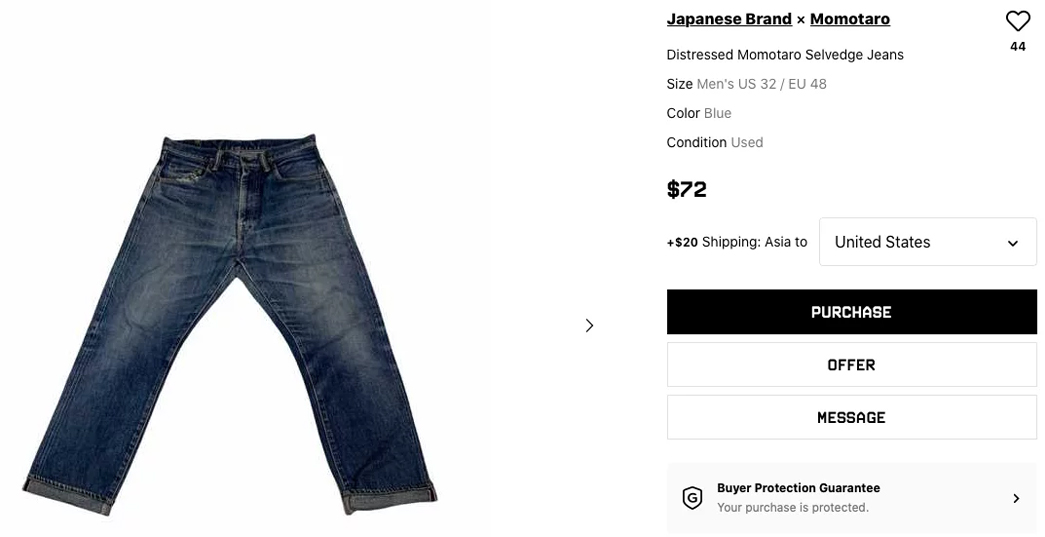
Image via Grailed
Grailed is a clothing-centric online platform full of name-brand designer clothing, streetwear, vintage, and workwear. Grailed’s app navigation is akin to a social media app, where you can create a profile along with a feed of product suggestions and a curated discovery page, etc.
Buying on Grailed
Pros:
- Convenient – Grailed is incredibly easy to purchase items from.
- Secure – Grailed has a zero-tolerance fraud policy, and items are authenticated before being submitted to the feed, so almost everything you’ll come across is authentic. You can open a case with Grailed if the seller hasn’t provided you with tracking information or your item after purchasing.
Cons:
- Inactive sellers/lack of information – Exercise patience on Grailed. Some items listed don’t have accurate measurements (or any measurements), enough photos, etc. Some sellers simply do not respond to inquiries or messages. If you feel that you don’t have enough information, or the seller isn’t responding, move on.
Selling on Grailed
Pros:
- Convenient and easy – Grailed’s app is straightforward and easy to navigate, and items go up in minutes (including authentication).
- Binding offer system – Grailed has an offer system whereby the buyers can make offers on items, but the offer is binding and requires the buyer to put in their payment details prior to submitting. This eliminates flaking and means if you get an offer you like, you’re item has sold!
- Clothing orientated- Grailed is dedicated to the buying and selling of designer and niche clothing, so it’s easy to find clothes from the brands you love.
- Bargains to be had – Due to the popularity and size of the platform, there are a lot of listings and lots of people looking for quick sales with items priced to sell. Do some decent scanning and you will find a bargain.
Cons:
- Sale configurations could be better – If you want to lower the price of your item on Grailed, it has to be done in 10% increments (these can be set automatically), which can be a lot of money depending on the item. This means that if you want to lower an item’s cost to a specific amount, you’ll have to relist the item at your custom price, which can be cumbersom.
- Higher Fees – Grailed takes 12% of sales, plus PayPal/payment processing fees, and you end up with a decent chunk of your money going to a third party, especially after shipping and handling’s all done. We highly recommend considering this when pricing your items.
- Hagglers and low-ballers – These exist on every platform, but for some reason, they’re very active on Grailed. Perhaps that speaks to the popularity/active user base on Grailed, but be prepared to answer masses of messages asking for a deal, which can sometimes be borderline offensive.
Etsy
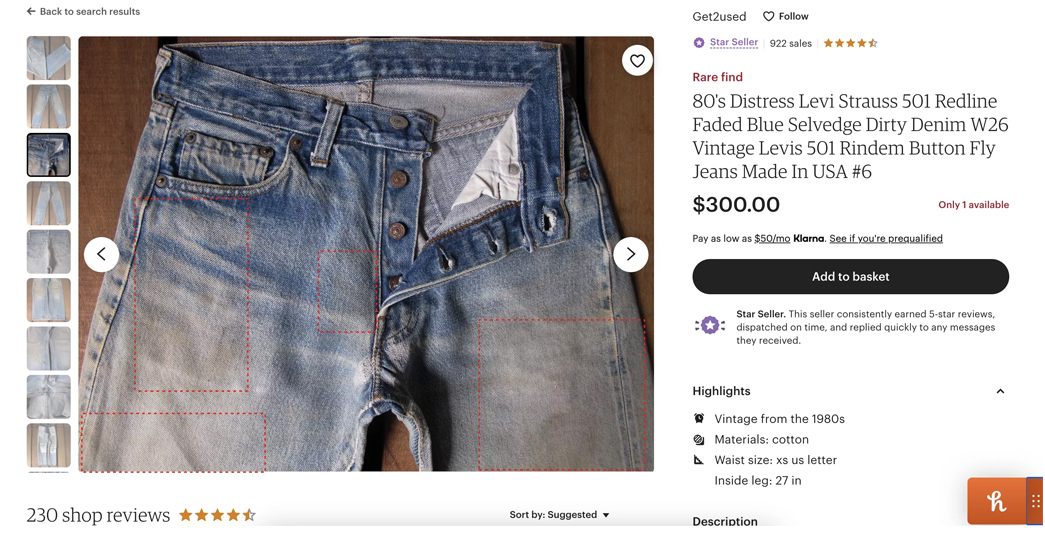
Etsy is a craft-based platform with countless independent businesses selling handmade wares, but there are also a ton of vintage and secondhand sellers out there. You’ll undoubtedly be able to find some vintage Levi’s on Etsy, and with some patience, maybe even some raw selvedge denim from modern brands.
Buying on Etsy
Pros:
- Rare items – You’ll find one-of-a-kind garments on Etsy from vintage/secondhand vendors. A lot of vintage dealers list exclusively through Etsy, so you are bound to find some hidden gems on here that simply aren’t available on other platforms.
Cons:
- Not as modern fashion-centric as other platforms – You might not find as much contemporary Japanese denim brands on Etsy as you would on say, Grailed, but there’s still some nice denim to be found here.
Selling on Etsy
Pros:
- Convenient – Whether you’re using Etsy on a computer or using their mobile app, opening an Etsy shop and listing items is quick and easy.
Cons:
- Fees – Listings start at $0.20, and then you’ll pay a transaction fee (6.5%), 3% commission fee, payment processing fee, and offsite advertising fees (15% if you decide to go this route). These might not be as high as some of the garment-centric platforms, but they should be factored into your pricing.
Depop
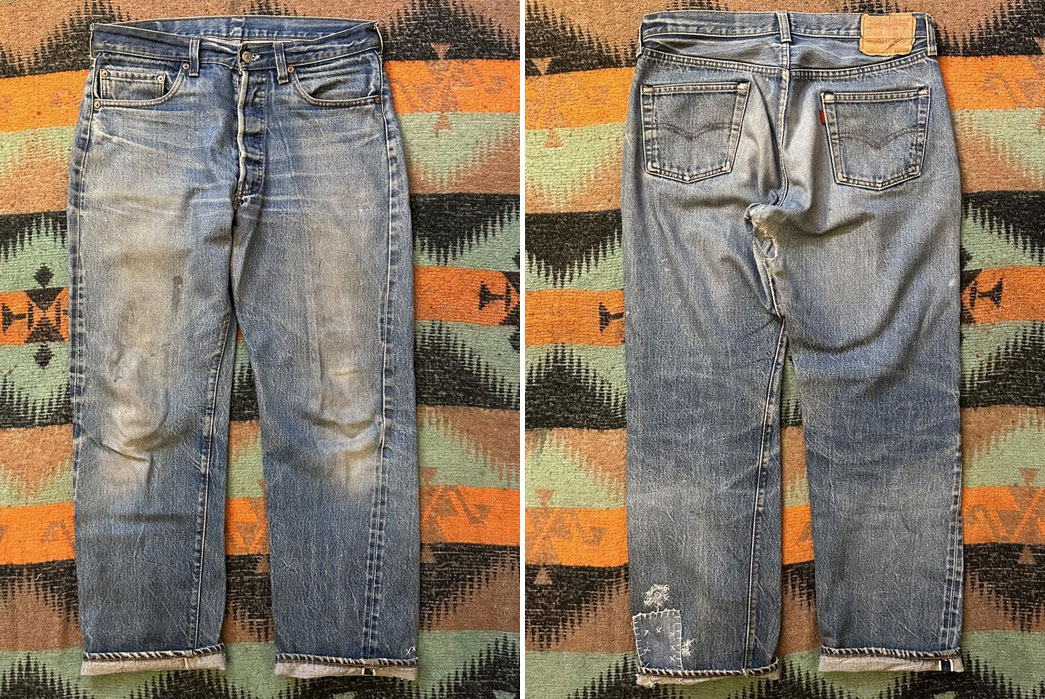
A pair of vintage selvedge Levi’s via Depop.
Depop is a similar platform to Grailed, where it functions like a self-contained social media app making searching and purchasing incredibly convenient. Tons of hip modern streetwear and workwear brands can be found on Depop, and, you guessed it, tons of denim.
Buying on Depop
Pros:
- Convenient – App-based with all of the perks like instant messaging, and intuitive and bold search mechanisms, it’s easy to find and purchase from sellers on Depop.
Cons:
- Sellers can only add 4 photos of items – This means you can’t always get a good look at the items you’re interested in.
- Not as many products as other platforms
Selling on Depop
Pros:
- Convenient – The Depop app makes it easy for you to list items using your smartphone.
Cons:
- Selling
- You can only add 4 photos to your listing – This means you can’t always portray the quality of a special item like a pair of raw denim jeans as well as on other platforms.
Marrkt
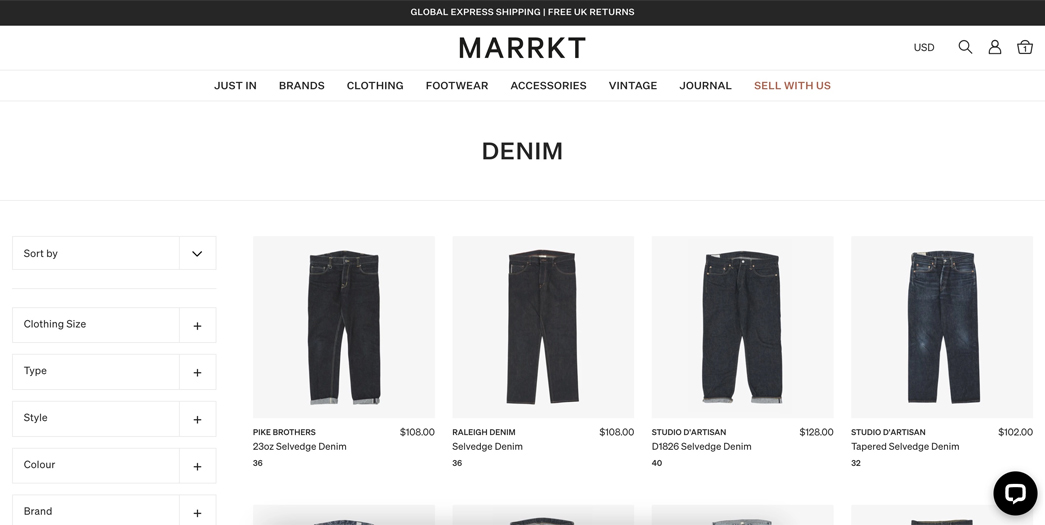
Marrkt is a menswear-focused consignment platform that sells items on behalf of its clients. The platform is absolutely chock full of heritage clothing and footwear from brands like The Real McCoy’s, Buzz Rickson’s, Drake’s, Warehouse, and many, many more.
Buying on Marrkt
Pros:
- Fully functional webstore – Marrkt is easy to purchase from. They’ve got measurements and high-quality photographs of all of their products, as well as a checkout with multiple payment options.
- Secure – Marrkt handles everything in the selling process, from storing and merchandising authenticated goods, to ensuring you receive your goods – there’s no chance of fraudulent activity.
- New items added daily – Marrkt is a growing platform that now adds a collection of new items daily.
- Email updates – Marrkt sends mailing list subscribers updates on the latest drops and discounts.
- Duty free – Whilst Marrkt is based in the U.K., purchases up to $800 are import tax and duty free.
- Returns – you can return the items you purchase – a rarity in the world of secondhand goods.
Cons:
- Menswear-centric – Unless you’re looking for menswear, you’re out of luck. Marrkt has listed a few ladies items in the past but it is 99% heritage menswear, workwear, and streetwear. This is probably a pro for most, but it could be a boon to you if you’re looking for specific brands or garments that don’t fit the platform.
- Commission fees – Marrkt earns a commission on the items they sell for their customers: 35% under $601, 25% over $601, plus a 2% transaction fee to cover payment processing fees.
Selling on Marrkt
Pros:
- Extremely convenient – Marrkt does all the selling for you. Simply fill out the form on the website to submit the items you’re interested in selling, and they’ll come back to you with a suggested sale price if they’re interested in selling it for you. From there, Marrkt supplies you with a shipping label to send the pieces to their HQ where they are photographed, measured, and uploaded to the site. Marrkt asks for a subsidized £25GBP contribution for shipping from North America.
- Curation – If accepted, your item will sit alongside thousands of products from the same realm.
Cons:
- High fees – With convenience comes a price, so be prepared to let a portion of the profits go to Marrkt, who handle all of the legwork involved in selling.
- Paying to ship items if you’re in North America/Canada – If you’re in the States or Canada, Marrkt asks you to contribute £25GBP towards the international shipping fee, which can cut into profits.
- Payment delay – Customers can return the items they purchase within 14 days. This means that if someone buys your item from Marrkt, the sale isn’t confirmed until after that returns period has elapsed. After this, the final payment may not reach you for a further 2-4 weeks.
- Can be slow – Depending on how in-demand your item is, it can take a while for someone to purchase your item.
Iron Heart Forum & Project RE:LOVE
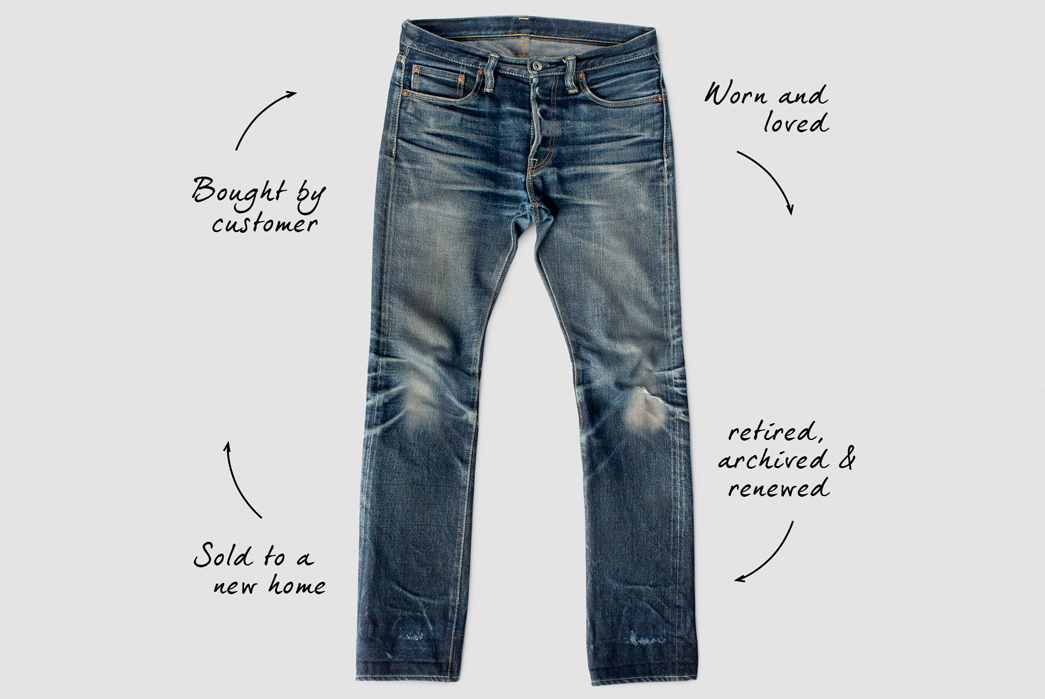
Image via Iron Heart.
Iron Heart, one of the most popular Japanese denim brands out there, has an amazing community forum where die-hard IH fans can participate in discussions and in the forum-integrated marketplace. While the forum’s marketplace isn’t exclusive to IH goods, you’ll find tons of secondhand heavyweight denim goods from the brand from fans of the brand, so you know you’re getting something legit and as close-to-the-source as possible.
Iron Heart provides a trade-in service for secondhand IH-made goods called Project RE:LOVE. Sellers can send in their old IH denim wares for store credit, and buyers looking for secondhand goods can reap the benefits by being able to buy already broken-in heavyweight denim at a cut price.
Buying from the Iron Heart forum & Project RE:LOVE
Pros:
- Secure – Project RE:LOVE provides secondhand Iron Heart denim direct from the source. There are zero worries about authenticity or fraudulent activity here.
- Reliable – The Iron Heart forums are filled with credible sellers obsessed with Iron Heart. Longstanding and trustworthy users will have a higher post count.
Cons:
- Iron-Heart centric- If the moto-inspired Japanese denim niche of raw denim isn’t your thing, this marketplace might not be your go-to. Project RE:LOVE is exclusively Iron Heart goods.
- You have to engage with the forum – This isn’t really a con as the IH community is great, but if you’re looking to just sign up and cop, that isn’t possible. You need to make 20 posts on the forum to unlock the forum’s marketplace section.
Selling on the Iron Heart Forum & Project RE:LOVE
Pros:
- Reliable
- No image limit
Cons:
- RE:LOVE only nets you 15% of the item’s original value in credit – Some Iron Heart fanatics might not mind the fact that they’re letting 85% of their item’s original value go, you rarely recoup all of your initial investment anyway, but that can be a lot of money for some when it comes to IH’s high-quality, high-pricetag goods.
- You have to engage with the forum – This isn’t really a con as the IH community is great, but if you’re looking to just sign up and sell, that isn’t possible. You need to make 20 posts on the forum to unlock the forum’s marketplace section.
Superdenim and Denimbro
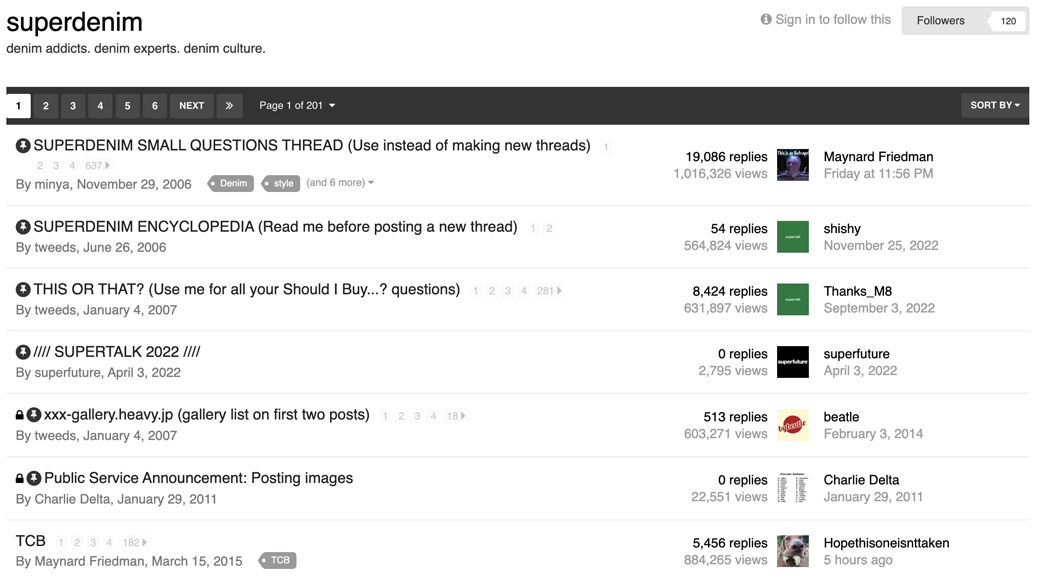
Superfuture’s denim forum Superdenim and Denimbro are two fashion-focused forums where you’ll find plenty of passionate and knowledgeable denimheads gathered to chop it up about all the finer points and details of denim at large. They both have market sub-forums and threads to buy, sell, and trade under.
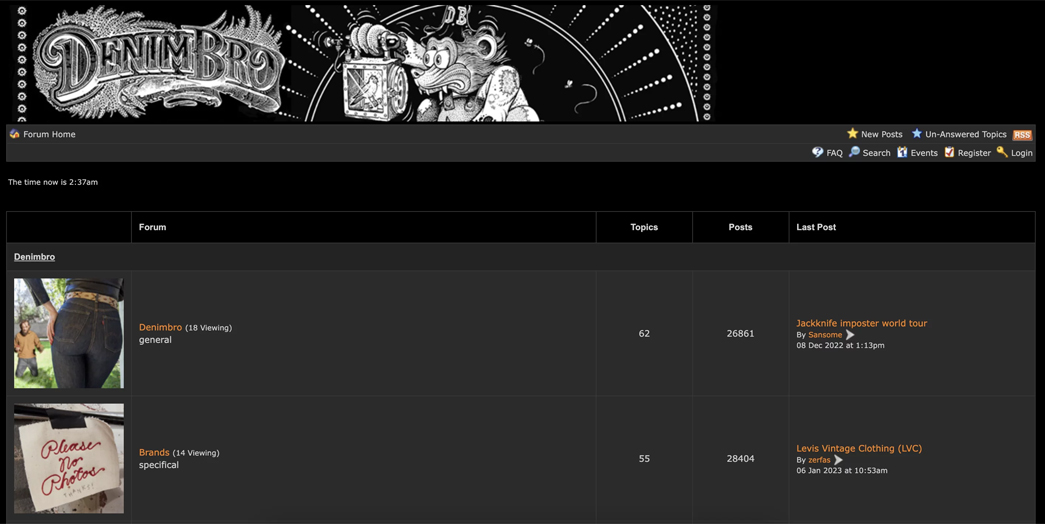
Buying on Superfuture/Denimbro
Pros:
- Rare items sold buy knowledgeable sellers – These forums attract the cult of quality-made denim, so you can rest assured you’re buying from someone who knows their product and can provide most information concerning quality, measurements, and fit.
Cons:
- Not as much readily available product as other platforms – You might have to be patient in order to find things that are your style, size, etc. There aren’t as many sellers on these platforms, as say, Grailed.
Selling on Superfuture/Denimbro
Pros:
- No fees – Selling direct to other forum members means no third party/middle-man taking a share of the profits.
- Reliable customer-base – Selling to other active, trustworthy members means you (hopefully) won’t have to worry about getting scammed.
Cons:
- Not as convenient as other platforms – These forums don’t have built-in market tools like storefronts/pages, pricing software, the ability to calculate/print shipping labels, etc. You’ll also need to get HTML codes or image links to insert your images into a forum post.
TheRealReal
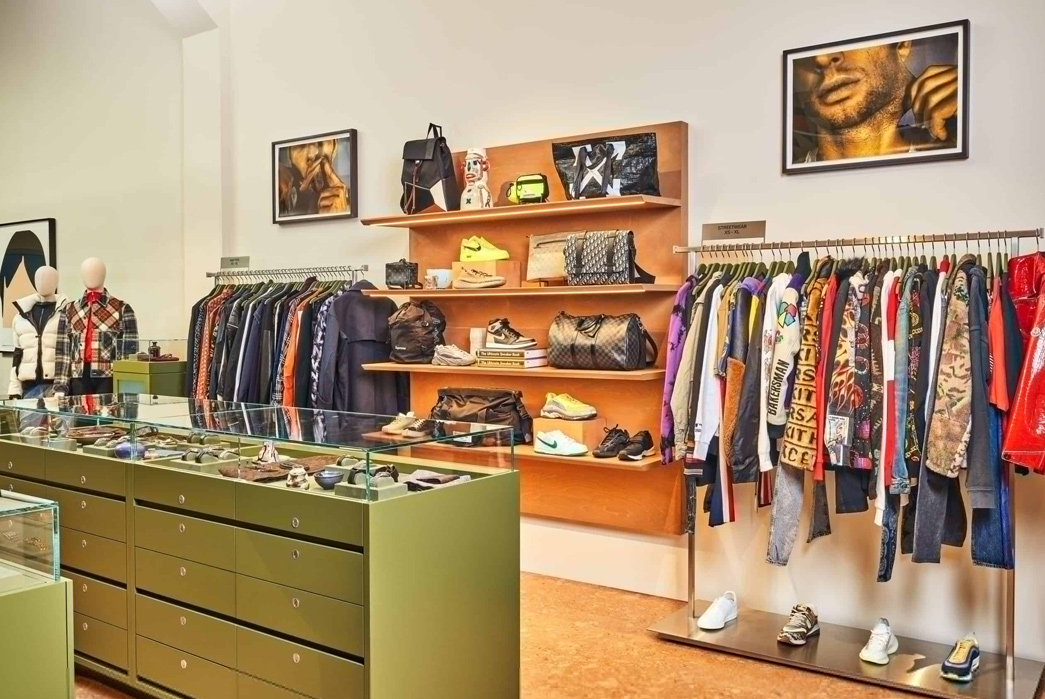
The RealReal Boorklyn store via Daily Front Row
TheRealReal is a typically high fashion-focused business, but let’s be realreal, modern Japanese denim isn’t exactly low-tier fashion. You can find tons of raw denim in TRR stores and sometimes on the website, and the nature of the platform means you’re buying high fashion at a lower price, for the most part. The website is first-come, first-served, with the ability to reserve/hold items you find.
Buying from TheRealReal
Pros:
- High-fashion at less than retail price.
Cons:
- Photos and details are often limited – TRR website typically doesn’t include more than 1-2 photos on their listings. Many times, model/product information is excluded, and measurements can also be limited. It’s a bit like TJ Maxx.
- Limited brick-and-mortar locations – More raw denim gooda can be found atr TRR’s physical stores, which are limited. There may not be one near you.
- Less heritage/niche labels – You are less likely to find goods from more niche labels, here.
Selling on TheRealReal
Pros:
- Convenient and informative – TheRealReal gives you an estimate of what your goods are worth even before sending it off to their team of consignment professionals.
- Reliable – TRR authenticates all of the items they sell, so potential customers have no concerns about purchasing fake items and can buy with confidence.
Cons:
- Commission fees – TheRealReal’s commission fees increase the higher the value of the item, but are at least 20% of the item, rising thereon if the item is valued over $99. For average-priced high-quality denim goods, that’s higher than most platforms.

Image via Reddit r/rawdenim
The raw denim subreddit on Reddit has a buy/sell/trade thread where Redditors can post their denim goods in varying states of wear, but most of the time, it’s high-quality stuff.
Buying on Reddit
Pros:
- Rare items sold by knowledgeable sellers
Cons:
- Lack of purchase protection – While some Redditors may have feedback via other Reddit users or other clothing purchasing platforms, you’re technically buying directly from a stranger. If you’re going this route, we strongly suggest paying via secure payment methods, like PayPal, so you have some form of cover.
Selling on Reddit
Pros:
- Reliable – You’ll find a ton of regular members on this platform who are seeking out deals on denim, so you can rest assured your items are listed in a place with the right eyes on them.
Cons:
- Not as convenient or market-centric as other platforms – Reddit is a message board, so your items might get lost in the mix on buying/selling threads.
Yahoo! Japan Auctions
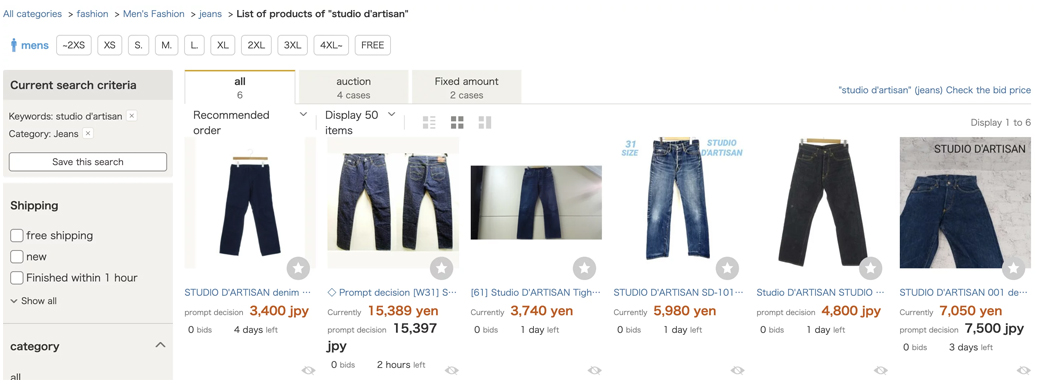
Yahoo! Japan Auctions is Japan’s most popular auction website. Like eBay, Yahoo! Auctions provides a wide-reaching, versatile platform with many different options available at any given time.
Buying on Yahoo! Japan Auctions
Pros:
- Can be cost-effective due to the auction format – You can get high quality goods at a steal with auction formats. When it comes to Japanese denim, you’re typically going to be paying less than Japanese retail most of the time, which leads to some serious savings.
- Rare items – Being a Japanese platform, you can obtain rare items that did not release in the West.
Cons:
- You need a proxy service – You cannot set up a Yahoo! account that works with Yahoo! Japan Auctions unless you are registered to a Japanese residential address. Furthermore, most sellers are not willing to post overseas to the West, therefore you must use a proxy service like Buyee! (official proxy service of Yahoo! Japan Auctions) or White Rabbit Express.
- You cannot browse Yahoo! Japan Auctions from Europe – Yahoo Japan! Auctions cannot be viewed from a UK/EU IP address.
- Needs translation – You will need to use a browser that translates Japanese to English.
People outside of Japan cannot sell with Yahoo! Japan Auctions.
Vintage/Consignment Stores and Secondhand/Flea Markets
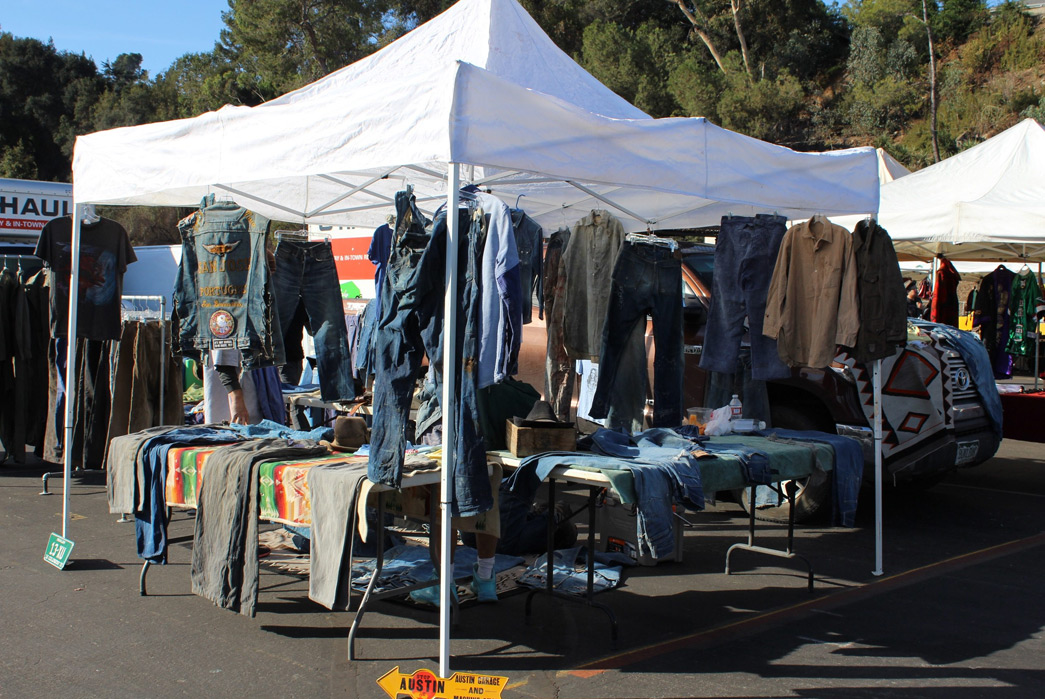
Image via Denimhunters
This list would be far from complete without mentioning vintage and secondhand markets. The good old-fashioned way. The vintage and secondhand market is huge, and you can find one-of-a-kind pieces at vintage stores and flea markets, often at reasonable prices.
Buying from secondhand retail vendors:
Pros:
- Supporting small business – If you’re able to scour your local vintage stores, flea markets, etc. You’re putting money into the hands of members of your community, as well as building relationships, which is never a bad thing. We recommend supporting local stores as often as possible.
- Try before you buy – In physical locations, you can try on secondhand denim goods before buying them.
Cons:
- May not have as much readily available product as other platforms – Vintage store stocks are in constant rotation, seasonally, and otherwise. It’s down to luck to find a piece of denim that you’re willing to buy, let alone a piece that’s in your size, or close to it.
- Pricing can be erratic – Whilst you can grab a bargain in any of these settings, you can also encounter heavily inflated prices in vintage stores and boutiques.
Risks (and how to mitigate them)
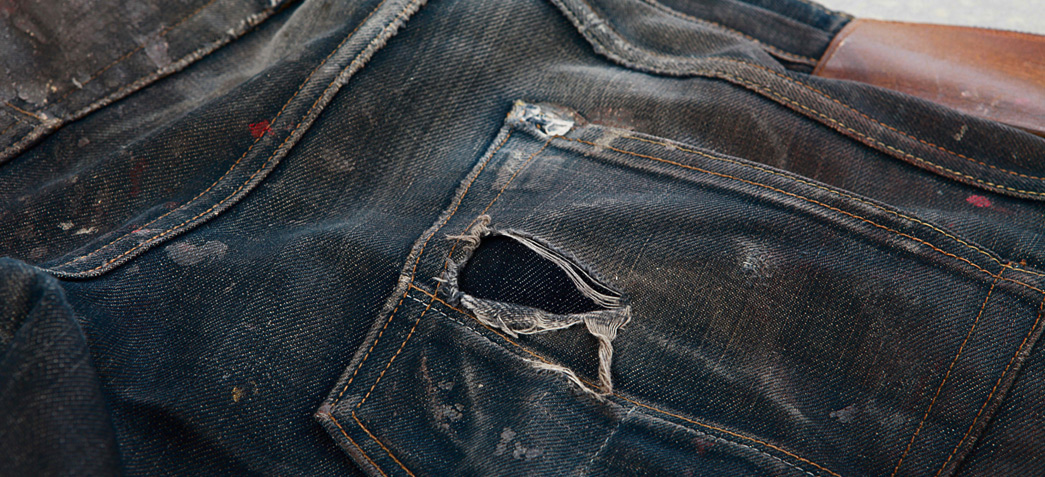
Some dirty raw denim via Tellason
Below are some of the risks you may be taking in purchasing secondhand denim, and how to avoid them. In the end, communicating any questions or hesitations you might have about the item prior to purchasing is the best risk mitigation.
Communicating concerns and questions is best done with respect for others’ time and knowledge, if a seller isn’t getting back to you quickly, exercise patience – we’re all busy. If a seller isn’t answering a question clearly, do your best to refine your inquiries, outside research (cross-referencing other listings/product pages) may be needed to understand product information or measurements if a seller isn’t being cooperative.
Rarely are there returns available
Buying secondhand typically means you’re buying at final sale. That’s why it’s important to thoroughly inspect the listing, read the description in its entirety, tally up the measurements, ask the seller questions, and do your research before purchasing. If you have concerns about anything prior to purchasing, check if the seller offers returns, but it is unlikely.
Purchasing Protection
Most of the platforms listed above are secure with purchasing protection included in your transaction, but if you’re buying direct from the seller outside of any of these platforms, pay via secure methods – i.e. PayPal. On the off-chance you send money to a scammer, who doesn’t provide you with your item, PayPal allows you to open a case against any hypothetical fraudulent seller.
Damaged/stained/smelly items
Any damage, stains, or odors should be viewable in the photos on the listing, or detailed in the description on the listing. Items purchased pre-owned are likely to include features of wear based on the time and amount of wear/washing put into them, which includes but isn’t limited to: Stretching, fading, staining, indigo transfer, indigo marbling, body odors, odors from washing/detergent/dust, etc. Not every single flaw can be accounted for on heavily worn denim goods.
If the item is poorly photographed, or there are details of the item that are missing, ask for more photos or closeups if you feel it’s necessary.
Measurements
Checking the listed measurements on an item is incredibly important when buying secondhand denim goods. Sometimes an item might be listed by size, which doesn’t always give you all the information you need when it comes to raw denim.
Knowing your measurements goes a long way, and it’s highly suggested that you measure 1-2 similar items that you have on hand in order to see what measurements you can take in the items you’re considering purchasing. Measure the items you have on hand thoroughly – if it’s a pair of jeans, measure the waist, inseam, thigh, knee, front rise, back rise, and hem. If the listing you’re considering buying is missing any of the measurements you need, ask for them. If the seller is slow to respond, or unable/unwilling to measure for you, consider cross-referencing measurements on another platform or retailer’s product page for the sizing information you need.
If a measurement looks off, ask the seller how they measured the item, sometimes items aren’t measured the exact same way every time. If the waist of a jean looks too narrow, ask if they laid the waistband flat across, or just pulled either side of the jean taught. Sometimes you get lucky and the seller will include measuring tape laid flat on the garment in the photo, which eliminates the guesswork in how the garment was measured.
Shrinkage/Stretching/Conforming
Sellers often include information about the washed condition of the denim good you’re looking to buy, which usually indicates how much shrinkage has occurred, or whether or not the garment can be shrunk at all – i.e. if it’s sanforized/unsanforized. If any information on the item’s fabric or state of shrink is missing, ask the seller for more details, how many washes/soaks, etc.
You can cross-reference details about the fabric and its tendency to shrink directly from the brand, retailers, or other listings, and apply this to your decision-making when buying secondhand raw denim. Say a pair of raw denim jeans is listed as “washed 3-4 times” but the measures provided by the seller match up to a brand new, unwashed pair, as indicated by an online retailer. This could mean that the seller has only ever washed the jeans super cold and they haven’t ever shrunk properly, or, they have washed them, and they have stretched back out to their original measures on the waist, etc. Best thing to do? Speak to the seller and ask about the denim’s journey, airing your concerns.
If a piece of raw denim isn’t pre-shrunk or washed prior to purchasing (i.e. you’re buying something that is secondhand but still BNWT) keep the potential for shrink in mind, that’s where information about the denim comes in handy. You’ll have to anticipate often roughly a full size of shrink on most unsanforized denim, and even some sanforized denim shrinks over time.
There are some ways to discern if an item has been shrunk or stretched without knowing much about the fabric itself. Chances are good that the denim has been rinsed/soaked/washed if the denim looks overall lighter in appearance, has significant fading, is soft and malleable, or is slightly crinkled in the way that a pair of rinsed jeans can be.
Chances are good that the denim has been stretched or conformed to its wearer’s body if there is noticeable bagging on the knees or seat, if there’s high contrast fading on the lap, thighs, or honeycombs developed on the knee ditch, or if the waistband looks stretched (there will be a significant crease by the waist button).
If the denim features high contrast fading throughout, keep in mind that those fades correspond to another person’s wear pattern and body type, it’s a risk you’ll have to take if you want pre-distressed denim.
Alterations
Altering clothes is a common practice, so it can be expected that sometimes you’ll come across altered denim on the secondhand market. Ideally, the seller/vendor will be transparent about any hypothetical alterations, but always be sure to inspect the items carefully. Do the general proportions seem off to you? Is there an unnaturally sharp taper past the knee? Does it look like the waistband has been taken in? Sometimes you can tell from a quick glance, or by the fact that the leather patch was moved/removed. If an alteration was done properly, you shouldn’t easily be able to tell that an item has been altered, but that’s typical of minor adjustments. Extreme alterations should be obvious.
It’s also comforting to know that if you’re eyeing a secondhand piece at a bargain, you yourslef can usually have them altered, and we highly recommend hiring a professional with experience working with denim. Small adjustments can be completed by most tailors.
Raw selvedge denim jeans come with a standard inseam of 37″, and while retailers often have a chain stitching machine and offer hemming upon purchasing, some people don’t want to risk making their jeans un-returnable and wait until the jeans arrive to have them hemmed. Keep in mind that a seller may not have had their jeans hemmed with chain stitching if this was not available to them in their area. Check the images and ask the seller if you’re unsure.
Product Information/Description
Pay close attention to the product description. If there’s any concern that the product is listed incorrectly, do a bit of research and cross-referencing in order to ensure you know what you’re getting. Most sellers aren’t out to deceive their customers, but if the fit or fabric of a pair of jeans is listed incorrectly, that can have a significant effect on your experience with them. Don’t purchase based on the product name alone, closely inspect the photos, description, and measurements.

